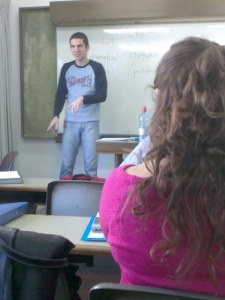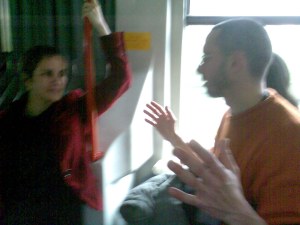
On the absence of glottal stop in modern Hebrew
this paper is an analysis of modern Hebrew gutturals. I will compare between two style levels to find evidence for the gutturals.
Style levels::
a language speaker can have a few separate grammars in his language. Two separate grammars can be almost identical except for having a different behaviour for a specific set of phonological or a syntactic phenomena. Each grammar represent a style level, a slightly different grammar that is appropriate in a specific context. The common style level, which is being used in most contexts by the language speaker, is referred as the “colloquial speech”. Since it is the style level being used the most, it is the one most likely to have changes. The style levels that are used only in specific contexts are referred as the “careful speech”. The “careful speech”, since it is not commonly used, is trying to preserve its unique grammar.
One of Modern Hebrew's phonological phenomenon is the lack of phonetic evidence of the three gutturals. The gutturals are historically separate phonemes that lost their distinguishing features. Hebrew has two style levels, the “colloquial speech” and the “careful speech”. Modern Hebrew (M.H) speakers don't produce gutturals In colloquial speech. the gutturals, /ʡ/ , /ʢ/and /h/ are represented as separate phonemes in the Hebrew orthography and spelling tradition. A guttural in word-initial is rarely produced, in most cases it is at sentence-initial. a guttural in mid-word followed by a vowel is almost never produced, instead, the guttural is deleted and a sequence of vowels is formed. Gutturals in word final are never realized and just mark a final-vowel.
(1)
/ʢ/ - pharyngeal fricative
/ʢ/ has disappeared completely and produced in neither careful nor colloquial speech. /ʡ/and/ʢ/have merged into /ʡ/.when it is produced in careful speech, /ʢ/ is almost always realized as /ʡ/.
| #_ | _V | _# |
| ʢa.mad > ʡa.mad > a.mad 'stand' | ba.ʢat > ba.ʡat > ba.at 'kicked' | ʃa.maʢ > ʃa.ma 'heard' |
| ʢa.kev > ʡa.kev > a.kev 'heel' | ma.ʢa.rav > ma.ʡa.rav > ma.a.rav 'west' | ma.tsaʢ > matsa 'menifest' |
| ʢa.da.jin > ʡa.da.jin > a.da.jin 'yet' | ʃmu.ʢa > ʃmu.ʡa > ʃmu.a 'rumour' | te.ʃaʢ > te.ʃa '9' |
(2)
/h/ - glottal fricative
/h/ is rarely produced in a careful speech and almost never produced in colloquial speech.
| #_ | _V | _# |
| ha.lax > a.lax 'went' | ni.hel > ni.el 'managed' | ka.rah > ka.ra 'happened' |
| ha.mon > a.mon 'a lot' | ka.hal > ka.al 'audience' | pa.rah > pa.ra 'cow' |
| hu > u 'he' | pi.hek > pi.ek 'yawn' | |
(3)
/ʡ/ - glottal stop
/ʡ/ is rarely produced in a careful speech and almost never produced in colloquial speech.
| #_ | _V | _# |
| ʡa.mar > a.mar 'said' | ʃa.ʡal > ʃa.al 'asked' | ki.seʡ > ki.se 'chair' |
| ʡa.gam > a.gam 'lake' | mar.ʡa > ma.ra 'mirror' | ba.raʡ > ba.ra 'created' |
| ʡa.val > a.val 'but' | me.ʡa > me.a '100' | |
A critical question rises from this data, does /ʡ/ exists in M.H? Even if M.H speakers are aware of the /ʡ/ phoneme, is it a part of their everyday language? The main problem in this data is that although most speakers will argue that they do produce /ʡ/, they never produce it in colloquial speech. Speakers will repeat the word in careful speech and correct their /ʡ/ deletion, but will delete it again in their next colloquial sentence.
Underline Representation:
in his book
1, Shmuel Bolozky analyse, among other Hebrew phenomena, the /ʡ/ behaviour. The question if the /ʡ/ exists in the underlying representation of the M.H speakers has a few solutions but no exact answer. “underlying gutturals are necessary for relating semantic information to patterns of phonological representation.” (p.57)
1. The reason for including the gutturals in the analysis is that some phonological rules are influenced by them.
(4)
singular > plural (verb):
| ʃoʡel+im > ʃoʡalim (ʃo.a.lim) | koʃer > koʃrim |
| nihel+a > nihala (ni.a.la) | kiʃer+a >kiʃra |
| boʢet+im > boʢatim (bo.a.tim) | koʃer > koʃrim |
The analysis shows a vowel lowering rule [+low] in a guttural environment. An e vowel is lowered to a when a guttural consonant is between two vowels. The basic motivation for this rule is to avoid a CC cluster, especially when it includes a guttural C. To explain such phenomena we would have to include the gutturals in our underlying representation analysis.
Bolozky points out in another example how gutturals affects vowels. If you want to connect between
mizrax 'east' and
maʢarav 'west' you would have to assume
mi-zarax ' from(where the sun) shines' and
mi-ʢarav 'from evening'. The /ʢ/ has lowered the morpheme's vowel to a. since we would like to assume a common origin to the two directions, a good solution to this would be the vowel lowering of gutturals.
Assuming underlying gutturals is problematic since speakers don't produce phonetical gutturals in “colloquial speech”. “one actually does not get such forms phonetically, since if /ʡ/ , /ʢ/and /h/ are (optionally) realized at all (which does not often happens in colloquial Hebrew) they are all realized as /ʡ/.” (p.62)
1. The distinction between the three gutturals is lost, and when they are realized, it is usually as a /ʡ/.
Data:
I recorded and analysed spoken M.H from the radio. For “careful speech” I used the news broadcast, which uses a strict style level of M.H. For “colloquial speech” I used interviews, which uses an everyday style level of M.H. The data I show here is just samples of the whole interview/news broadcast, which I analyzed fully.
In this data I collected all noun, verb and adjective phrases that include one of the gutturals in an onset, mid-word or coda position. I ignored all /ha/ determiners and functional words which has /ʡ/ or /ʢ/ such as: ʢim 'with', ʢal 'on' and ʡet (direct object marker). /h/ in coda possition is a final-vowel marker and never realized, and so not analyzed as well. Both /ʢ/ and /ʡ/ are also found in coda position but has no difference from the /h/ coda, all these are final-vowel markers.
all data is presented in the appendices. The data was analysed by the program “praat”. When I analyse a /ʡ/ as not realized it means I did not find a complete stop and a plossive in the “praat”'s analysis. Instead of the /ʡ/, a vowel continues through that slot. A /ʢ/ not realized is when I did not find a typical fricative behaviour, that would look more like an /f/ or a /v/. instead, just like in the case of the /ʡ/, I find a vowel. /h/ would also look like a fricative, when not realized it is a continuing vowel.
Colloquial speech:
these interviews have been taken from the radio show “ hakol diburim” at “reʃet bet” radio station. The words counted in this table contain underlying gutturals, most of which are not realized as gutturals at all.
(5)
| HD1 | HD2 |
| words | 212 | 291 |
| Onset | 29 | 64 |
| mid-word | 55 | 50 |
| coda | 1 | 5 |
HD1 – interview with Avigail danieli, head of social services of the orthodox Jewish community in Jerusalem.
HD2 – interview with Oded menashe, a television host.
ʡʢ
HD1:
HD1.1 – anaxnu naase 'we will do'
HD1.2 – keesrim ovdim, ovdot beikar 'twenty worker (male), workers (female) mostly'
HD1.3 – letsaari 'unfortunately'
HD1.4 – maamasa meʡod kaʃa 'very hard burden'
HD1.5 – mea ʃearim 'hundred gates'
HD1.6 – ovdim beʃeket ubetsina 'work quietly and in modesty'
In HD1.1 a /ʡ/ is not realized in anaxnu, although it is the first onset in a sentence . /ʢ/ is not realized in naase. Neither a /ʡ/ nor a /ʢ/ are realized in HD1.3, 5 and 6. in HD1.2 /ʢ/ is not realized in any of the four word. Although She repeats herself with
ovdot 'workers (female)'
,still no /ʢ/ is realized. The only realized /ʡ/ found on this interview is HD1.4. /ʢ/ in maamasa is not realized but the /ʡ/ in meʡod is realized. She is emphasizing the degree Phrase
meod 'very' and actually produces a /ʡ/.
HD2:
HD2.1 – ʡahavnu veyadanu 'we loved and knew'
HD2.2 – haijim haavudim 'the lost islands'
HD2.3 – magia 'coming'
HD2.4 – mekomot kaele baarets 'places like these in the country(Israel)'
HD2.5 – prutot laatid 'coins for the future'
HD2.6 – rak aruts exad 'only one channel'
HD2.7 – sfinat haahava 'the love boat'
HD2.8 – ʃvil zahav 'a golden path'
In HD2.2-8 non of the gutturals are realized. The only /ʡ/ found on this interview is in HD2.1. A /ʡ/ is realized in ahavnu. /h/ is not realized in ahavnu 'we loved' and neither is the /ʢ/ in yadanu 'we knew'. he gets into a climax in his story at this point and so chooses to produce a /ʡ/ for emphasizing.
Careful speech:
these broadcasts have been taken from the daily news broadcasts at “reshet bet” radio station.
(6)
| NEWS | P1 | P2 | P3 | P4 |
| Word | 245 | 371 | 239 | 272 |
| onset | 45 | 29 | 29 | 25 |
| mid-word | 41 | 74 | 43 | 66 |
| Coda | 4 | 4 | 6 | 5 |
P1 – a news broadcast with malachi chizkiyah
P2 – a news broadcast with dan kaner
P3 – a news broadcast with malachi chizkiyah
P4 – a news broadcast with tsvi salton
News P1:
News P1.1 – ʡasara mafginim 'ten protesters'
News P1.2 – exad meem 'one of them'
News P1.3 – niftsa halajla kal adam 'a man was lightly injured'
News P1.4 – beejlu hitnaxlujot 'in which settlements'
News P1.5 – gormim falestinim omrim 'Palestinian agents say'
News P1.6 – hakpaa zmanit 'temporary freeze (stop)'
News P1.7 – hakpaa muxletet 'complete freeze (stop)'
News P1.8 – laiton El xajat 'to the El xayat newspaper'
News P1.9 – leyoʃev roʃ hareʃut abu mazen 'chairman Abu mazen'
News P1.10 – ʃekvar hexelu 'that already began'
in NewsP1.1 a /ʡ/ is realized instead of the /ʢ/ that is underlined in
ʢasara 'ten'. it is the first onset in the first sentence of this broadcast. In contrary to NewsP1.2 which is also a beginning of a sentence and a /ʡ/ is underlined, but the /ʡ/ is not realized. Instead of the first syllable to be a CV – ʡe.xad 'one', the first syllable is a V - e.xad 'one'. Non of the gutturals in NewsP1.3-10 are realized.
News P2:
News P2.1 – al pi haatsaa 'by the proposal'
News P2.2 – ansu vehitalelu 'raped and abused'
News P2.3 – ʡejna mutelet besafek 'is not doubted'
News P2.4 – hadriʃa haamerikanit 'the American demand'
News P2.5 – hegiʃa axotam 'their sister applied'
News P2.6 – huʃʡa mitafkido 'was suspended from duty'
News P2.7 – medinot haolam 'countries of the world'
News P2.8 – neʢenʃu 'were punished'
News P2.9 – nexkeru veheeviru 'were interrogated and delivered'
News P2.10 – savlu mehitalelut 'suffered an abuse'
News P2.11 – ʃeba ezraxim 'in which citizens'
News P2.12 – tluna laum – 'a complaint to the U.N'
in NewsP2.2 two gutturals are realized , a /ʡ/ in
ʡansu 'raped' and a /ʢ/ in
itʢalelu 'abused'. The /h/ that is underlined in
hitʢalelut is not realized. In NewsP2.3 a /ʡ/ is realized in ʡejna 'not'. In NewsP2.6 a /ʡ/ is realized,
uʃʡa instead of the /ʢ/ that is underlined,
uʃʢa, /h/ is not realized in the onset. In NewsP2.8 a /ʢ/ is realized in
neʢenʃu 'were punished'. In NewsP2.10 a /ʢ/ is realized in
itʢalelut 'an abuse', /h/ is not realized. In NewsP2.12 a /ʡ/ is realized in
laʡum 'to the U.N'. there are no gutturals realized in NewsP2.1,4,5,7,9,11.
News P3
News P3.1 – emeʃ hora bejt miʃpat 'last night the court instructed'
News P3.2 – gorem amerikani baxir 'a major American agent'
News P3.3 – ivir (hivhir) emeʃ 'clarified last night'
NewsP3.1-3 are just samples of non gutturals, in this whole broadcast I did not find any gutturals. In NewsP3.3 the word are actucally connected and /e/ of emeʃ is the vowel after /r/ of ivir which becomes I.vi.re.meʃ.
News P4:
News P4.1 – bidrom mizrax asja 'in south east Asia'
News P4.2 – haarox 'the long'
News P4.3 – irgun amnesti omer 'amnesty organisation says'
News P4.4 – meanim 'torture'
News P4.5 – el erduan 'to (with) Erduan (turkey's P.M)'
News P4.6 – Ankara 'Ankara (Turkey's capital)
News P4.7 – erduan 'Erduan (turkey's P.M)'
in NewsP4.1,
mizrax (ʡ)asja 'east Asia', it looks as if there is a stop since /x/ is right before where the /ʡ/ is underlined, but by looking closely we can see there is no complete stop and the /a/ vowel is not completely broken. In NewsP4.2 a /ʢ/ is realized,
meʢanim 'torture'. In NewsP4.5 a // is realized in a beginning of a sentence.
ʡel erduan hits.taref 'someone joined Erduan' , the /
ʡ/ is realized in the functional word in this case because of its non-typical syntactic structure (object-verb-subject). The name of the P.M Erduan remains without a /ʡ/. non of the gutturals in NewsP4.2,3,6,7 are realized.
Optimality theory(OT):
one of the main characteristic of OT is the claims that two grammars can differ from one another just by the ranking of their constraint. OT uses sets of constraints (CON) to demonstrate a specific phenomena. The constraints are divided into markedness (MCON) and faithfulness (FCON). MCON produce an output different then the input, FCON produces an output that is as close as possible to the input. There is a similarity between the MCON and the FCON and to the two style levels. while the “colloquial speech” is not producing what that is underlined in that language, the “careful speech” will try to preserve what that is underlined. Since two grammars can differ in just the ranking of their CON, and two style levels are two grammars then two style levels can differ in only the ranking of their CON.
The similarity between the CON and the style levels is being analysed in Marc van Oostendorp article
2. In his article he shows that in a colloquial style level the MCON will be ranked higher, and in a careful style level the FCON will be ranked higher. The hypothesis appears in the article as:
(1) “The more formal the style level the higher ranked the faithfulness constraints.” (P.209)
he analyses French, Dutch and Turkish style levels and present the different style levels and their CON ranking. It seems that the more strict the style level is the lower the MCON are ranked. If we try to observe the Hebrew style levels through this hypothesis we would find a similar pattern. assuming Bolozky's underlined gutturals, we should have MCON that delete them and FCON that surface them.
Constraint:
Surface C:
As a FCON we can use Surface C, a CON similar to ident which will try prevent the deletion of the gutturals. A C from the input must be produced in the output. In our case the C is a guttural.
*G or *ʢ:
As a MCON we can use *G (no gutturals) or one of its specific forms, *h or *ʢ. A guttural in the input will not be produced in the output.
We may take, for example, NewsP1.1 asara 'ten' which surfaced as ʡasara but was underlined as ʢasara, for tableau (7.1):
(7.1)
| /ʢa.sa.ra/ | *ʢ | Surface C | *ʡ |
| ʢa.sa.ra | * | | |
| ʡa.sa.ra | | * | |
| a.sa.ra | | ** | |
Tableau (7.1) shows the “careful speech” in which
ʡasara is the chosen candidate, a *ʢ is blocking the FCON from surfacing the underlined /ʢ/. perhaps the MCON are restricted to a specific locations, such as *ʢ#_, a /ʢ/ is forbidden as an onset, since /ʢ/ is surfaced in other cases.
(7.2)
| /ʢa.sa.ra/ | *ʢ | *ʡ | Surface C |
| ʢa.sa.ra | * | | |
| ʡa.sa.ra | | * | |
| a.sa.ra | | | ** |
Tableau (7.2) shows the “colloquial speech” in which
asara would be chosen. The FCON is ranked low, both gutturals are blocked and not produced. Both MCON are not necessarily ranked in that order, but they are ranked higher then the FCON.
(8)
| (rak) /ʢa.ruts ʡe.xad/ | *ʢ | *ʡ | Surface C |
| ʢa.ruts ʡe.xad | * | * | |
| ʢa.ruts e.xad | * | | |
| a.ruts ʡe.xad | | * | |
| a.ruts e.xad | | | ** |
Tableau (8.1) shows the “colloquial speech”, it was taken from HD2.6. FCON is blocked by both MCON, no gutturals produced. In a “careful speech” we might have found
ʢaruts exad or
aruts ʡexad, probably not
ʢaruts ʡexad.
(9)
| /huʃʢa/ | *ʢ | *h | Surface C | *ʡ |
| uʃʢa | * | | * | |
| huʃa | | * | * | |
| uʃʡa | | | | * |
| uʃa | | | ** | |
| huʃʢa | * | * | | |
Tableau (9) shows again how a /ʡ/ is chosen over a /ʢ/, although *h and *ʢ are blocking the FCON *ʡ is still ranked lower than the FCON. At least one of the candidates must be with a /ʡ/,A C is chosen although it is not even in the input. since all three gutturals lost their distinguishing features /ʡ/ is chosen. Perhaps the FCON is choosing out of the natural group of the gutturals, and so /ʡ/ is chosen as the only guttural not forbidden. This example was taken from NewsP2.6.
Hypothesis (1) predicts correctly the case of M.H. Theoretically, there could be a more strict style level in which the FCON is ranked higher than the rest of the MCON, in that case we would get an output which is identical to the input. In the case of tableau (9)
huʃʢawould have been chosen in that style level. The “careful speech” used in the radio news broadcast is not strict enough and still many gutturals are not realized.
Since I found little evidence to the gutturals in either colloquial and careful speech I must ask if what I call a “careful speech” is really a style level that functions as a complete grammar in M.H. It seems as if both style levels produce a guttural in specific contexts. I think this pragmatic context is the simple request of “being clear”, delivering a massage in the brightest way. In that context there is a need of using a more strict style level. In both HD1 and HD2 we find gutturals realized, which means that in that specific context they wanted to make sure they are understood. The NewsP data shows a larger amount of gutturals realized but still most of the are not. Although the newsman is supposed to be clear at all time he still chooses the specific contexts to realize gutturals.
The “being clear” context has some kind of a connection with reading. When someone needs to read for an audience he will try to be more careful in his speech and therefore choose a more strict style level. Since the gutturals are represented in the orthography, while reading we are exposed to them much more then we are when speaking naturally. The newsman is reading out loud the news, he is more aware of the gutturals and therefore produces more. Perhaps the difference between the two style levels should not be observed in this manner but to observe when do speakers choose to use the different style levels. Observing specific contexts might show the usage of style levels.
While listening to the HD2 interview I noticed something, while the interviewer
3 (int.) of Oded Menashe was asking him questions she used the same style level as he did. After the interview and a short commercial there was a little time buffer until the next show. In that spare time the int. decided to read a fax. She switched to her “careful speech”, producing four gutturals in a short fax. This incident shows that reading out loud makes a speaker restrict their speech.
Another incident was while listening to a recording of a philosophy seminar. the lecturer was reading to us out of Plato's republic, trying to be extra clear at 9 AM. He was not only realizing gutturals but emphasizing /ʢ/s. While he was lecturing in a regular talk he did not make a single guttural. Style levels seem depended on the “be clear” context, the more strict the style level the clearer it should be to the listener.
has the glottal stop really disappeared? In all that data I collected all I saw between two vowel, where a guttural was suppose to be, was another vowel continuing the vowel before and changed to the next vowel. Mostly a a vowel but also other vowels as well. In those cases there was no complete stop as it suppose to be if a glottal stop was produced. A long vowel is produced if the vowel are the same,
ʃa.ʡal >ʃaal'asked'. When the two vowels are different a diphthong is produced. Although the diphthongs are not phonemes in M.H, they are still produced when two different vowel are brought together.
One phenomena concerning diphthongs is that a front high vowel /i/ followed by a different vowel is creating a palatal glide in between them. On the other side trapeze the back high rounded vowel /u/ is creating a bi-labial glide /w/. looking at the praat analysis showed me how similar those vowels are to their matching glide. Both glides are voiced and are the highest consonants in the sonority level, the closest to the vowels which are the highest. The difference between the highest and lowest in sonority level is by the level of obstacles in the way of the voice coming out through the vocal chords. The voice is air coming through the vocal chords. Each obstacle in his was produces a different sound. The vocal chords has to be vibrating in order for the air to become voice, otherwise it will be voiceless. Vowels are voiced which means while we produce a vowel the vocal chords vibrate. A glottal stop is produced by completely closing the vocal chords and then exploding the air pressured beneath it. after that air went through the vocal chords, if it is followed by a vowel, we will be able to produce an ʡa sound. That sound is repeated through all vowels, the sound of air streaming through the vibrating vocal chords. The glottal is located exactly above the vocal chords it is the closest place of articulation near it.
the connection between the gutturals and the a vowel, as pointed out by Bolozky, seems like it has something to do with its closeness to the vocal chords. If XiaX produces XijaX and XuaX produces XuwaX what would XaaX or XaoX produce? Could there be a glide that would match the a vowel? A glide like that would have to be a glottal glide since it is the deepest place of articulation. Such a phoneme is not included in the IPA table, the approximant glottal box is empty. But trying to produce it creates the same voice we make as a vowel. Spreading the vocal chords apart as far as possible, vibrating them and push the air out. That is the same sound one make when just singing a tune without words, just a long vowel changing with the tune. Perhaps that long vowel created instead of the deleted glottal stop is actually a glottal glide. If all three gutturals have collapsed into this one phoneme it would explain why they are all produced as the same. It would also explain why we could not spot it in the praat, it looks the same as a vowel since it is the sound of a vowel.
Conclusion:
a glottal stop appears in both colloquial and careful speech, at a very low rate which is depended on specific contexts. Since we underline the gutturals in M.H and cherish them with orthography I believe their extinction will be a lot slower but inevitable. Perhaps the glottal glide replacing the gutturals is another way of preserving the origin of M.H, it fills the guttural slot that was left behind, and allows it to recreate the original guttural when the context calls for a clearer style level. Such a solution might explain why M.H speakers refuse to believe at first that they do not produce gutturals, since they do produce a glottal glide which feels like using the glottal for producing a guttural.











